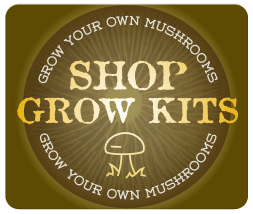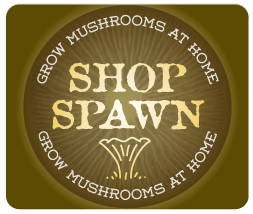Chicken of the woods mushroom is a true gourmet mushroom that’s a favorite to eat for many mushroom lovers … and we are working on its cultivation
I get this question a lot: What is your favorite mushroom?
As a professional mushroom farmer and an avid mushroom forager, my answer is a really young, tender, and fresh chicken of the woods mushrooms. It is an incredible mushroom to eat because it is so juicy and succulent.
Chicken of the woods is also known as the sulphur shelf mushroom, referring to its bright orange and yellow or white pores. It’s a very bright, vibrant mushroom you can find while foraging in the forest. It’s scientific name is Laetiporus sulphureus or Laetiporus cincinnatus. The mushroom is called the chicken of the woods because its texture is said to resemble the texture of cooked chicken. We agree wholeheartedly.
Chicken of the woods are most commonly foraged in the wild. They are frequently found growing from wounds of oak trees or at the base of the tree. The mushroom can also be found on some types of conifers, sweet chestnut trees or willow trees.
In the Northeast, these mushrooms appear from early spring to late autumn. If the weather conditions are appropriate, the mushrooms can come back year after year. Unlike some mushrooms, chicken of the woods are a great option for freezing. If you find an abundance while foraging, or if you end up growing your own like we discuss below, then you can freeze the bounty that you do not consume while fresh.
Growing chicken of the woods mushrooms at home
Chicken of the woods is interesting because it is so delicious yet the ability to cultivate it is difficult. Most mushroom farmers do not know how to grow it and there are not any consistent production methods for growing this mushroom. So we are left with this interesting predicament.
We are exploring how to cultivate this mushroom and there are a lot of spawn providers that are trying to reliably grow this mushroom. I have seen a few farms successfully fruit chicken of the woods through inoculating logs. This has been done with the similar strategy used for growing shiitake mushrooms on logs, which involves drilling holes into the logs, filling the holes with plug spawn, sealing the holes, and letting the logs sit.
Since we love chicken of the woods and have seen some farms successfully fruit them, we are offering chicken of the woods plug spawn through our website. Growers can experiment with this mushroom on their own now.
What I have learned involving the process of growing chicken of the woods
Chicken of the woods takes a bit longer to fruit than shiitakes. For instance, it may take two years for the fruiting to begin. The success rate in fruiting the chickens will also be lower than that with shiitakes. It is a little bit more experimental.
When foraging I typically find this mushroom on oak or maple trees. Those would be ideal types of wood to use if you are trying to cultivate these mushrooms at home.
Here in the Northeast you can find the chicken of the woods growing from May through October. Keep your eyes peeled for the bright orange shelf-life creature growing off the edge of downed trees.
If you do want to try growing your own chicken of the woods because they are so delicious and beautiful, I’d recommend inoculating a downed oak tree with the chicken of the woods plug spawn that we have available through our website. This would be an ideal option for inoculation, and since chicken of the woods can lead to abundant yields, you may be able to develop a consistent source for fresh mushrooms for years to come.
We hope you can develop a long-lasting relationship with this amazing mushroom. If you want to try growing them in your backyard, garden, or commercially, then check out our chicken of the woods plug spawn now.
Preparing chicken of the woods mushroom
Chris Sturk, the digital marketing manager at Fungi Ally, loves chicken of the woods mushroom as well. His favorite method of preparing this mushroom is by lightly breading it with some gluten-free breadcrumbs. He first makes an egg wash, dunks the pieces of chicken of the woods into the egg wash, and then rolls the mushroom pieces into the breading. He then bakes the chicken of the woods mushroom at 400 degrees F until the coating is slightly browned.
Another great option is the chicken of the woods mushroom tikka masala. You can use pre-packaged tikka masala sauce, which is the easiest method. Cook the chicken of the woods mushrooms in some oil for a few minutes and then put them in the sauce and simmer. This goes great on rice, pasta, or riced cauliflower.




This article sparked my interest because it’s the most recent discussion of someone attempting to cultivate it! I’ve read many people’s blogs/threads on their efforts but haven’t seen any recent attempts.
Have you read the Polish study where they got a successful fruiting? They used a mixed substrate as opposed to logs. I’m not sure if they experimented with fresh logs either. There is a consistent account on shroom boards of one in Israel and Thailand too but trace documentation is all to be found on those. But the Polish experiment is published.
I’m extremely interested in the market viability of this mushroom, above all else I see it as one of nature’s true meat analogues and I think it could be marketed well in the mock meat market… would be great to see chicken mushrooms on the shelves next to the seitan, jackfruit and pea/soy isolate based analogues. It’s just waiting to be figured out with enough efficiency/consistency to be scaled up.
If you start running any experiments would it interest you (it would certainly interest me! lol) to share the process on the blog/YouTube?
I have to believe the market for this mushroom is enormous. Anyone getting it into commercial production is going to be handsomely rewarded. I have to wonder is a substrate made from brewing by-products might work. I will look for that paper out of Poland. Thanks for the info.
Rick-
I too believe the market would be considerably ready for it. Between the growing demand for gourmet/wild mushrooms and meatless meat-like products… I think this mushroom has a foot in both of those. Personally, I’d actually push in the alternative meat direction and what’s awesome is that this is entirely from nature, it’s not a texturized protein isolate, which I believe broadens the appeal to more of the omnivore crowd. The vegan/vegetarian market will take it on immediately.
I believe the issue is that the mycelium tears through substrate too quickly and the conditions for fruiting are difficult. I’m curious though, could one start a “farm” by plugging multiple freshly cut hardwood logs? I’d image it’d be a challenge to scale but it seems interestingly worth the experimentation. Sometimes it wont fruit in its first year.